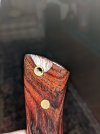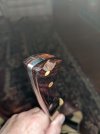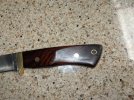- Joined
- Nov 7, 2015
- Messages
- 113
I am trying to figure out what to do with my first real knife, bought in 1982 for a whopping $54.00. That was a lot of money back then. I eyed it for a number of months in a knife shop in Crabtree Valley shopping center before I finally bought it. It is a Benchmark, I believe designed by Blackie Collins, and manufactured in Gastonia, N.C, about 30 miles from where I grew up. Anyway, 30 years or so I dropped the knife and it chipped the one piece handle. Looking for ideas or referrals to someone who may be able to fix this with some sort of epoxy resin or maybe even replace the whole handle. Although I am pretty good at woodworking, and have replaced a number of 2 piece handles/scales, this is more than I think I want to tackle. This knife has been relegated to the miscellaneous outdoor stuff drawer, and I really want to get it back on my belt. It's not a huge deal I realize, but the chip is just something that bothers me. Ideas? Know anyone who could repair/replace this handle?




